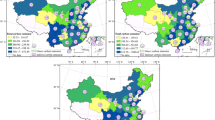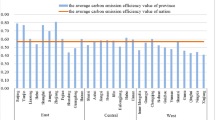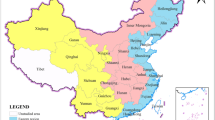Abstract
As the largest contributor to global carbon emissions (CEs), construction industry (CI) is regarded as one of the most significant sources in China. Previous studies on carbon emission (CE) of CI, however, are often limited to the quantitative level and provincial or local administrative unit scales, lacking relevant studies at the spatial raster resolution scale, due to data limits. Here, using the energy consumption, social economic data, and a series of remote sensing data from EU EDGAR, this study explored the spatial–temporal distribution and changing characteristics of CEs from CI in typical years of 2007, 2010, and 2012. This study found, from 2007 to 2010, then 2012, in addition to subtle differences, that the direct, indirect, and total CEs of CI all showed an increasing trend overall. In all provincial units except Tianjin and Guangdong, indirect CEs took up more than 50% of the total CEs, which can clearly indicate the “dominant low carbon, recessive high carbon” characteristics of CI. The direct, indirect, and total CEs of the CI in 2007, 2010, and 2012 all showed a positive spatial clustering. Specifically, hot spots were mainly distributed in Beijing-Tianjin-Hebei and Yangtze River Delta, and cold spots were mainly focused in the west and northeast of China, presenting a similar distribution pattern with population-economy characteristics. These findings can provide references for the policy formulation of regional differentiated emission reduction.






Similar content being viewed by others
Data Availability
The data will be available upon reasonable request.
References
Acquaye AA, Duffy AP (2010) Input-output analysis of Irish construction sector greenhouse gas emissions. Build Environ 45(3):784–791
Chang Y, Ries RJ, Wang Y (2010) The embodied energy and environmental emissions of construction projects in China: an economic input-output LCA model. Energ Policy 38(11):6597–6603
Chuai XW, Huang XJ, Lu QL, Zhang M, Zhao RQ, Lu JY (2015) Spatiotemporal changes of built-up land expansion and CEs caused by the Chinese CI. Environ Sci Technol 49(21):13021–13030
Chuai XW, Lu QL, Huang XJ, Gao RY, Zhao RQ (2020) China's construction industry-linked economy-resources environment flow in international trade. J Clean Prod 278:123990
Chuai XW, Gao RY, Huang XJ, Lu QL, Zhao RQ (2021) The embodied flow of built-up land in China’s interregional trade and its implications for regional carbon balance. Ecol Econ 184(4):106993
Crippa M, Guizzardi D, Muntean M, Schaaf E, Dentener F, van Aardenne JA, Monni S, Doering U, Olivier JGJ, Pagliari V, Janssens-Maenhout G (2018) Gridded emissions of air pollutants for the period 1970–2012 within EDGAR v4.3.2. Earth Syst Sci Data 10(4):1987–2013
Cui C, Wang Z, Bin GS (2019) Life-cycle CO2 emissions and their driving factors in construction sector in China. Chinese Geogr Sci 29(2):293–305
Du Q, Wu M, Wang N, Bai LB (2017) Spatiotemporal characteristics and influencing factors of China’s CI carbon intensity. Pol J Environ Stud 26(6):2507–2521
Guo J, Zhang YJ, Zhang KB (2018) The key sectors for energy conservation and CEs reduction in China: evidence from the input-output method. J Clean Prod 179:180–190
Hendrickson C, Horvath A (2000) Resource use and environmental emissions of US construction sectors. J Constr Eng M 126(1):38–44
Hong J, Shen GQ, Guo S, Xue F, Zheng W (2016) Energy use embodied in China’s CI: a multi-regional input–output analysis. Renew Sust Energ Rev 53:1303–1312
Huang LZ, Bohne RA (2012) Embodied air emissions in Norway’s construction sector: input-output analysis. Build Res Inf 40(5):581–591
Huang LZ, Krigsvoll G, Johansen F, Liu YP, Zhang XL (2018) Carbon emission of global construction sector. Renew Sust Energ Rev 81:1906–1916
Huang X (2012) Research on design and evaluation and simulation optimization method of energy-saving building modular system. Ph.D Dissertation. Wuhan University of Technology, Wuhan
Huang Y, Duan H, Dong D, Song Q, Zuo J, Jiang W (2019) How to evaluate 598 the efforts on reducing CO emissions for megacities? Public building practices 599 in Shenzhen city. Resour Conserv Recycl 149:427–434
Khamraev K, Cheriyan D, Choi JH (2021) A review on health risk assessment of PM in the CI – current situation and future directions. Sci Total Environ 758:143716
Kokoni S, Skea J (2014) Input-output and life cycle emissions accounting: applications in the real world. Clim Policy 14(3):372–396
Li B, Han SW, Wang YF, Li JY, Wang Y (2020a) Feasibility assessment of the CEs peak in China’s CI: factor decomposition and peak forecast. Sci Total Environ 706:135716
Li DZ, Huang GY, Zhang GM, Wang JB (2020b) Driving factors of total CEs from the CI in Jiangsu Province, China. J Clean Prod 276:123179
Li QP, Wu SM, Lei YL, Li ST, Li L (2021) Evolutionary path and driving forces of inter-industry transfer of CO2 emissions in China: evidence from structural path and decomposition analysis. Sci Total Environ 765:142773
Li W, Sun W, Li GM, Cui PF, Wu W, Jin BH (2017) Temporal and spatial heterogeneity of carbon intensity in China’s CI. Resour Conserv Recy 126:162–173
Liang D, Wang YQ, Wang YJ, Ma C (2019) National air pollution distribution in China and related geographic, gaseous pollutant, and socio-economic factors. Environ Poll 250:998–1009
Lin BQ, Liu HX (2015) CO2 mitigation potential in China’s building CI: a comparison of energy performance. Build Environ 94:239–251
Liu YY, Wang YQ, Li D, Feng F, Yu Q, Xue SQ (2019) Identification of the potential for carbon dioxide emissions reduction from highway maintenance projects using life cycle assessment: a case in China. J Clean Prod 219:743–752
Meng J, Mi ZF, Guan DB, Li JS, Tao S, Li Y, Feng KS, Liu JF, Liu Z, Wang XJ, Zhang Q, Davis SJ (2018) The rise of South-South trade and its effect on global CO2 emissions. Nat Commun 9:1–7
Moran D, Kanemoto K (2016) Tracing global supply chains to air pollution hotspots. Environ Res Lett 11(9):094017
Onat NC, Kucukvar M, Tatari O (2014) Scope-based carbon footprint analysis of U.S. residential and commercial buildings: an input-output hybrid life cycle approach. Build Environ 72:53–62
Pandey D, Agrawal M, Pandey JS (2011) Carbon footprint: current methods of estimation. Environ Monit Assess 178(1–4):135–160
Qi SJ, Zhang YB (2013) Research on carbon footprint flow track and low-carbon development strategy in Chinese CI. Build Simula 6:10–16
Rong TQ, Zhang PY, Zhu HR, Jiang L, Li YY, Liu ZY (2022) Spatial correlation evolution and prediction scenario of land use carbon emissions in China. Ecol Inform 71:101802
Shi Q, Chen GD, Shen LY (2017) Driving factors of the changes in the CEs in the Chinese CI. J Clean Prod 166:615–627
Wang H, Zhang X (2008) An analysis on the resource consumption in the Chinese CI. Constr Manag Econ S1:7–11
Wang J, Wang Z, Peng S, Li C, Wei LY (2020a) Tracing CO2 emissions of China’s construction sector. J Clean Prod 275:124165
Wang JX, Zhong HY, Yang ZF, Wang MM, Kammenet D, Liu Z, Ma ZM, Xia Q, Kang CQ (2020b) Exploring the trade-offs between electric heating policy and carbon mitigation in China. Nat Commun 11:6054
Wang Z, Cui C, Peng S (2019) How do urbanization and consumption patterns affect CEs in China? A decomposition analysis. J Clean Prod 211:1201–1208
Wang Z, Wei LY, Niu BB, Liu Y, Bin GS (2017) Controlling embedded carbon emissions of sectors along the supply chains: a perspective of the power-of-pull approach. Appl Energ 206:1544–1551
Wen W, Wang Q (2020) Re-examining the realization of provincial carbon dioxide emission intensity reduction targets in China from a consumption-based accounting. J Clean Prod 244:118488
Wu P, Song YZ, Zhu JB, Chang RD (2019) Analyzing the influence factors of the CEs from China’s building and CI from 2000 to 2015. J Clean Prod 221:552–566
Xi JP (2020) Speech at the General Debate of the 75th Session of the United Nations General Assembly. State Council of the People’s Republic of China, Beijing, China
Yan H, Shen QP, Fan LCH, Wang YW, Zhang L (2010) Greenhouse gas emissions in building construction: a case study of One Peking in Hong Kong. Build Environ 45(4):949–955
Yang D, Zhang PY, Jiang L, Zhang Y, Liu ZY, Rong TQ (2022) Spatial change and scale dependence of built-up land expansion and landscape pattern evolution-case study of affected area of the lower Yellow River. Ecol Indic 141:109123
ZabalzaBribián I, Usón A, Scarpellini S (2009) Life cycle assessment in buildings: state-of-the-art and simplified LCA methodology as a complement for building certification. Build Environ 44(12):2510–2520
Zhang PY, Yang D, Qin MZ, Jing WL (2021) Spatial heterogeneity analysis and driving forces exploring of built-up land development intensity in Chinese prefecture-level cities and implications for future urban land intensive use. Land Use Policy 99:104958
Zhang W, Liu Y, Feng KS, Hubacek K, Wang JN, Liu MM, Jiang L, Jiang HQ, Liu NL, Zhang PY, Zhou Y, Bi J (2018) Revealing environmental inequality hidden in China’s inter-regional trade. Environ Sci Technol 52(13):7171–7181
Zhang XL, Shen LY, Zhang L (2013) Life cycle assessment of the air emissions during building construction process: a case study in Hong Kong. Renew Sust Energ Rev 17:160–169
Zhang YJ, Bian XJ, Tan W, Song J (2017) The indirect energy consumption and CO2 emission caused by household consumption in China: an analysis based on the input–output method. J Clean Prod 163:69–83
Zhang ZH, Liu RJ (2013) CEs in the construction sector based on input-output analyses. J Tsinghua Univ Sci Technol 53(1):53–57
Zhang ZY, Wang B (2016) Research on the life-cycle CO2 emission of China’s construction sector. Energ Build 112:244–255
Acknowledgements
The authors thank the anonymous reviewers for their valuable comments to improve the quality of the manuscript.
Funding
This research has been supported by the Frontiers Science Center for Critical Earth Material Cycling Fund, China (DLTDPY2101) and the Natural Science Foundation of Guangdong Province (2020A1515010730).
Author information
Authors and Affiliations
Contributions
Project administration and funding acquisition: X.C. Review and editing: X.C. Writing—original draft and methodology: X.G. All authors have read and agreed to the published version of the manuscript.
Corresponding author
Ethics declarations
Conflict of interest
The authors declare no competing interests.
Additional information
Responsible Editor: Philippe Garrigues
Publisher's note
Springer Nature remains neutral with regard to jurisdictional claims in published maps and institutional affiliations.
Rights and permissions
Springer Nature or its licensor (e.g. a society or other partner) holds exclusive rights to this article under a publishing agreement with the author(s) or other rightsholder(s); author self-archiving of the accepted manuscript version of this article is solely governed by the terms of such publishing agreement and applicable law.
About this article
Cite this article
Guo, X., Chuai, X. Tracking the spatial–temporal distribution and regional differences of carbon footprint in grid scale of China’s construction industry. Environ Sci Pollut Res 30, 67187–67199 (2023). https://doi.org/10.1007/s11356-023-27149-0
Received:
Accepted:
Published:
Issue Date:
DOI: https://doi.org/10.1007/s11356-023-27149-0




